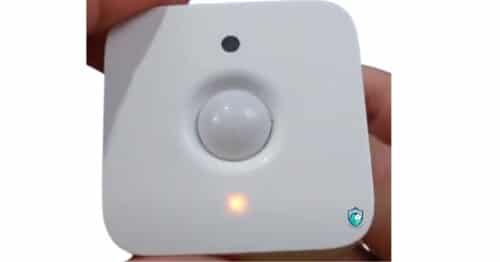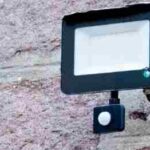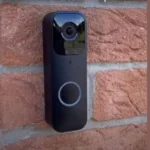Have you ever being worried why is your Hue Motion Sensor Red Light? Yes, The light turning red on a Hue motion sensor usually means there’s a problem.
I ran into this after my Hue system was working flawlessly for over a year.
At first I was baffled why the motion automations suddenly stopped working. Seeing that ominous glowing red light made me worried my Hue system was broken.
After some frantic troubleshooting, I figured out the cause and got my motion detection working again. Calming that initial panic and walking through the issue methodically turned out to be the key.
In this blog, I’ll explain exactly how to diagnose and fix a Hue motion sensor with a red light. I want to help you resolve this painlessly so you don’t have to stress like I did!
Let’s dive in!
Philips Hue motion sensors are a popular accessory for smart home and lighting automation systems. The sensors can detect movement in a room and trigger actions like turning lights on or activating Philips Hue scenes.
One common question from Hue users is why the motion sensor’s LED status light turns red. Typically, the light on the front of the sensor is white or blue when operating normally. When this LED turns a solid red color, it is often an indication of some kind of issue.
There are a few main reasons why your Hue motion sensor may have a red light. Pinpointing the cause can help you troubleshoot the problem and get your motion automation working properly again.
Reasons Your Hue Motion Sensor Red Light
Here are the most common culprits for a Hue motion sensor displaying a red LED status light:
Connectivity and Pairing Problems
One of the most frequent reasons your Hue motion sensor light turns red is connectivity problems and losing its pairing or link with the Hue bridge.
These sensors communicate wirelessly via Zigbee to the Hue bridge. If this connection is interrupted for some reason, the motion sensor will turn solid red.
You’ll also notice that any automations involving the sensor will stop working.
Try manually pairing the motion sensor to the bridge again through the Philips Hue app. Go into the settings menu, choose lighting setup, and add accessory. You can initiate the pairing process by tapping the button on the bottom of the sensor.
Firmware updates to the Hue bridge can also sometimes cause temporary connectivity issues. You may need to re-pair sensors after substantial firmware updates.
Faulty Hardware
Another possibility for a solid red LED light is a hardware failure or defect within the motion sensor itself. If the internal components malfunction, it can activate the red LED.
You may notice other symptoms like the sensor not detecting motion events properly. Test this by waving your hand in front of the sensor and seeing if the LED flashes blue when it senses movement.
Start with some basic troubleshooting like power cycling the motion sensor. Turn the sensor over and press the button 5 times in quick succession to cycle the power. See if this resets the light back to normal white/blue operation.
If the hardware issue persists, you may need to replace the defective unit under warranty if possible. Continuing to operate a malfunctioning motion sensor will likely result in ongoing issues.
Low Battery
A red blinking LED light on your Hue motion sensor often means it has low battery. The battery inside the sensor enables continuous operation without wiring.
These motion sensors have an estimated battery life of 1-2 years depending on usage patterns. More motion events and triggers will deplete the battery faster over time.
When the battery needs to be replaced, the red LED will blink as an indicator. Follow the proper steps to safely change the CR2450 coin cell battery inside your Hue motion sensor. Make sure to observe polarity as you insert the new battery.
Motion Detection Triggers
Some Hue users notice the motion sensor LED turning red when it detects movement and triggers automation. This behavior is normal and expected.
The reason the LED turns red during motion activation is to provide a visible indicator that motion was sensed. The brief flash of red light shows that the sensor is working correctly and saw the motion event.
You can adjust the sensitivity of the motion detection in the Hue app if needed. Reduce the sensitivity if you find the red activation light turning on too frequently. This may help reduce the number of false positive motion events.
How to Troubleshoot a Hue Motion Sensor Red Light
If your Hue motion sensor has a persistent red light, follow these troubleshooting tips to resolve the issue:
- Check the connectivity status in the Philips Hue app – often connectivity problems are the root cause.
- Try manually pairing and syncing the sensor to your Hue bridge again, even if it shows as registered.
- Update your Hue bridge and motion sensor firmware to the latest versions.
- Test positioning the sensor closer to the Hue bridge temporarily during testing.
- Carefully inspect the hardware for any damage, cracks, moisture or other faults.
- Monitor when exactly the red light activates – is it solid or blinking? Constant or intermittent?
- Replace the battery if you notice a blinking red light when motion is not detected.
- Consider performing a factory reset on the sensor and clearing all settings.
- Contact Philips Hue support if you cannot resolve the red light issue through troubleshooting.
Thoroughly troubleshooting the problem based on the red light clues can help identify the correct cause. Rule out software and connectivity issues before replacing hardware.
Resetting Your Hue Motion Sensor Red Light
You may want to reset your Hue motion sensor if you are troubleshooting connectivity problems or want to clear all custom settings. Here are the steps to factory reset a Hue motion sensor:
- Turn the sensor over to locate the small circular button near the Philips logo.
- Press and hold this button continuously for around 10 seconds.
- Keep holding until the LED light blinks 3 times. On the 3rd blink, release the button.
- The sensor will now reset itself and clear any paired connections or settings. The LED will turn solid red.
- You can now go through the process of pairing the motion sensor to your Hue bridge again. Follow the instructions in the Hue app to sync and connect.
Resetting clears any weird connectivity or motion detection behaviors by restoring factory defaults. Try resetting as part of your troubleshooting when dealing with a red LED issue.
When to Replace Your Faulty Hue Motion Sensor Red Light
If you have thoroughly tried troubleshooting and cannot resolve a persistent red light issue, replacement may be necessary for a faulty unit. Here are signs it may be time to replace your Hue motion sensor:
- Hardware damage or defects that cannot be fixed. This may include leaking batteries, cracked housing, damaged motion sensor, etc.
- Unstable connectivity and pairing issues that persist after troubleshooting.
- Erratic motion detection behavior like false positives or lack of triggering.
- The LED light remains solid red after resetting and pairing again.
- Sensor is no longer covered under Philips warranty.
You have a few options for replacing failed or defective Hue motion sensors:
- Claim any remaining Philips warranty coverage if possible. Sensors have a 2-year limited warranty.
- Purchase a brand new Philips Hue motion sensor. They retail for around $40 USD.
- Consider compatible Zigbee motion sensors from third parties like Sengled. These are often cheaper.
- Try finding used/refurbished sensors online but test carefully before installing.
Ideally, get a replacement from Philips under warranty if your sensor is defective. Otherwise, the official Hue motion sensors provide the most seamless and integrated experience if within budget.
Adjust the sensitivity of the Hue Motion Sensor
To adjust the sensitivity of the Hue Motion Sensor, you can follow these steps:
1. Open the Philips Hue app on your smartphone or tablet.
2. Select the motion sensor you want to adjust from the list of devices.
3. Tap on “Settings” and then “Accessory settings.”
4. Scroll down to “Motion sensitivity” and adjust the slider to your desired level.
5. Save the changes.
It’s important to note that the specific steps may vary depending on the version of the Hue app you are using.
Additionally, some users have reported issues with the sensitivity settings not working as expected. If you encounter any problems, you may want to try resetting the motion sensor and starting the setup process again.
FAQs To Hue Motion Sensor Red Light
How Long Does Battery Last In Philips Hue Motion Sensor?
The battery life of the Philips Hue motion sensor is estimated to be 1-2 years depending on usage. Frequent motion activations and lots of triggering will drain the battery faster.
The Hue sensor uses a CR2450 coin cell battery that should provide up to 20,000 hours of operation. Check for a blinking red light on the sensor to indicate a low battery needing replacement.
Why Did My Motion Sensor Light Stop Working?
There are a few reasons why your Hue motion sensor light may have stopped working: lost connectivity to the Hue bridge, faulty hardware like a dead battery, interference from other devices, positioning outside wireless range, accumulation of dirt/dust blocking the sensor, exceeding the number of paired sensors, or needing a manual reset.
Troubleshoot by checking for error lights, replacing the battery, cleaning the sensor, testing closer proximity to the bridge, and resetting pairings.
What Causes A Motion Sensor To Stop Working?
Common causes for a motion sensor to stop working include loss of power from dead batteries, buildup of dirt/debris blocking the sensor, physical damage to hardware components, wireless interference from other devices, exceeding maximum pairing limits, loss of connectivity, incorrect positioning or installation, and defective/faulty units.
Troubleshooting the specific issue and ruling out software issues before replacing hardware can help get motion detection working again.
How Many Years Do Philips Hue Last?
The expected lifespan of Philips Hue smart lights is around 15,000-22,000 hours or 15-22 years based on 3 hours of daily use.
This can vary based on use patterns. Other Hue components like the bridge and motion sensors tend to last around 5-10 years.
Bulbs may fade over time but the LED chips maintain efficiency. Hardware is replaceable if faulty but Hue supports devices via updates for many years.
How Do I Check The Battery On My Hue Motion Sensor?
To check the battery level on a Hue motion sensor, look at the status LED light on the front. A solid or blinking red light indicates low battery that needs replacement.
No light or color change when motion is detected also shows dead battery. The Hue app may also show a low battery warning for paired sensors. Use a CR2450 coin cell battery as a replacement, taking care to match polarity.
How Do I Check The Battery Level On My Hue Motion Sensor?
Unfortunately the Hue motion sensor does not provide a way to get an exact battery percentage remaining. The only battery level indicator is a red blinking LED when the battery is nearing end of life and needs replacement.
There is no gradual battery level readout. Check for a low battery warning in the Hue app which may advise replacing battery without giving a precise figure. Estimated battery life is 1-2 years.
Why Is Philips Discontinuing Hue?
Philips is not discontinuing their popular Hue smart lighting platform. They continue to release updated products, apps, and evolve the Hue ecosystem.
Philips has discontinued some older Hue bulbs and hardware that have been replaced by newer models. Support and firmware updates still enable legacy Hue devices to work.
Phillips remains committed to supporting Hue and growing the platform.
Is Philips Hue Ending?
No, Philips is not ending their Hue smart home lighting system. Since its release in 2012, Hue has grown into an expansive ecosystem of bulbs, fixtures, sensors, switches and accessories.
Philips continues to develop the platform with new product releases, app updates, and support. Some legacy Hue hardware models get discontinued but the system lives on with backwards compatibility.
Philips plans to expand Hue into more smart home integration and possibilities.
Do Hue Lights Use A Lot Of Electricity?
Hue smart LED lights are very energy efficient and use minimal electricity. Estimates indicate Hue bulbs on average consume about 10 watts for a bright white LED A19 bulb.
This equates to around $1 or less per year for typical household use. Much less energy is used compared to traditional incandescent lighting. Installing Hue bulbs can reduce lighting costs for most homes.
How Do You Replace A Battery In Hue Motion Sensor?
To replace the battery in a Hue motion sensor, first remove it from the wall/ceiling mount. Flip the sensor over to expose the bottom with the Philips logo. Locate the coin cell battery and use a tool to pry it out from the compartment.
Insert a new CR2450 battery with correct polarity, positive side visible. Snap the cover back on and remount the Hue sensor. Re-pair the sensor if needed.
Why Wont My Battery Operated Motion Sensor Light Turn Off?
If your battery operated motion sensor light won’t turn off, the most likely cause is that the light sensor is being triggered continuously.
Try cleaning the sensor to remove dirt, dust, or insects that may be blocking detection. Adjust sensitivity and timer settings using the app or hardware dials. Test the sensor in another location to isolate issues. Dead batteries that cannot provide consistent power can also cause lights to remain on.
How Do I Know If My Motion Sensor Light Is Working?
Some ways to test if a motion sensor light is working properly include:
- Observe if the light comes on when motion is detected in range
- Look for a green or blue indicator on the sensor when active
- Wave your hand in front of the sensor to see if it responds
- Check that the light fixture itself still has power
- Monitor if any connected apps or devices activate when motion is detected
- Adjust sensitivity higher and watch for the light to come on
- Consider temporarily moving the sensor closer to the motion source
- Look for any signs of physical damage, dirtiness, battery issues impeding operation
Conclusion
Hopefully this provides some clarity on why your Philips Hue motion sensor may have a red LED light instead of blue or white. The most common causes are connectivity issues, low battery, faulty hardware, or normal motion triggered activations.
Carefully troubleshooting the exact behavior of the red light can help isolate the issue. Solid vs blinking red lights indicate different problems. Follow a step-by-step process to resolve software issues before replacing hardware.
Knowing when to factory reset vs change the battery vs replace the sensor entirely will fix your problems faster. Getting your Hue motion automation working properly again provides huge convenience.
Additional resources like the Philips Hue support site and community forums can also help troubleshoot tricky motion sensor issues. Let the clues of the red LED guide you to the root cause.




